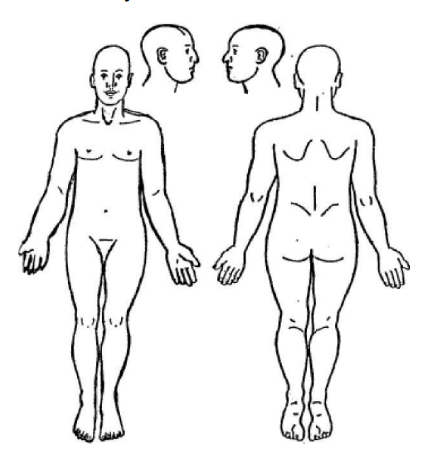Title Page
-
Patient Name
-
Hospital / Ward
-
Treating Doctor
-
Conducted on
-
Conducted by
Physical Health
Focused Geriatric Physical Examination
-
Vital Sign
-
Area examined
-
Physical sign or symptom
-
Differential diagnosis
General
-
Area examined
-
Physical sign or symptom
-
Differential diagnosis
Functional Ability
Activities of Daily Living (ADL)
-
Bathing
-
Dressing
-
Toileting
-
Transferring
-
Fecal and urinary continence
-
Feeding
Other activities
-
Activity
-
Functional status
Instrumental Activities of Daily Living (IADL)
-
[This portion of the assessment is a self-rated type of evaluation. Patients are required to complete this questionnaire.]
Directions: For each question, select the answer that best applies to your situation. -
Can you use the telephone?
-
Can you get to places that are out of walking distance?
-
Can you go shopping for groceries?
-
Can you prepare your own meals?
-
Can you do your own housework?
-
Can you do your own handyman work?
-
Can you do your own laundry?
-
Do you use any medications?
-
Do you take your own medication?
-
If you had to take medication, could you do it?
-
Can you manage your own money?
Nutrition
Nutritional Screening
-
Complete the screen by filling in the boxes with the appropriate numbers. Add the numbers for the screen. If the score is 11 or less, continue with the assessment to gain a Malnutrition Indicator Score.
Screening score (subtotal max. 14 points)
12-14 points: Normal nutritional status
8-11 points: At risk of malnutrition
0-7 points: Malnourished -
I have an illness or condition that made me change the kind or amount of food I eat.
-
Weight loss during the last 3 months
-
Mobility
-
Has suffered psychological stress or acute disease in the past 3 months?
-
Neuropsychological problems
-
Body Mass Index (BMI) (weight in kg) / (height in m2)
Nutritional Assessment
-
Assessment Score (max. 16 points)
Get total Malnutrition Indicator Score by getting the sum of Screening and Assessment.
24 to 30 points = Normal nutritional status
17 to 23.5 points = At risk of malnutrition
Less than 17 points = Malnourished -
Lives independently (not in nursing home or hospital)
-
Takes more than 3 prescription drugs per day
-
Pressure sores or skin ulcers
-
How many full meals does the patient eat daily?
-
Selected consumption markers for protein intake:
-
At least one serving of dairy products (milk, cheese, yogurt) per day<br>
-
Two or more servings of legumes or eggs per week
-
Meat, fish or poultry every day
-
What is the majority response in the 3 items above?
-
Consumes two or more servings of fruit or vegetables per day?
-
How much fluid (water, juice, coffee, tea, milk...) is consumed per day?
-
Mode of feeding
-
Self-view of nutritional status
-
In comparison with other people of the same age, how does the patient consider his / her health status?
-
Mid-arm circumference (MAC) in cm
-
Calf circumference (CC) in cm
Initial Pain Assessment Record
-
Click 'Add a photo' button to add a reference photo and add your annotations on areas where the patient is likely to feel pain.
-
REFERENCE: [This is an example of how you can use iAuditor to include reference images in your templates to assist with inspections]
-
Pain score/rating
-
Patients own description of pain(s) - including pain score on assessment
-
Summary of pain(s) history
-
What makes pain better?
-
What makes pain worse?
-
Aims of pain management
-
Select words that best describe the pain
- Tender
- Crushing
- Squeezing
- Stabbing
- Sharp
- Electric shock
- Aching
- Sore
- Burning
- Continuous
- Intermittent
- Occasional
- Throbbing
- Dull
- Discomfort
Completion
-
Name & Signature of Assigned Physician






